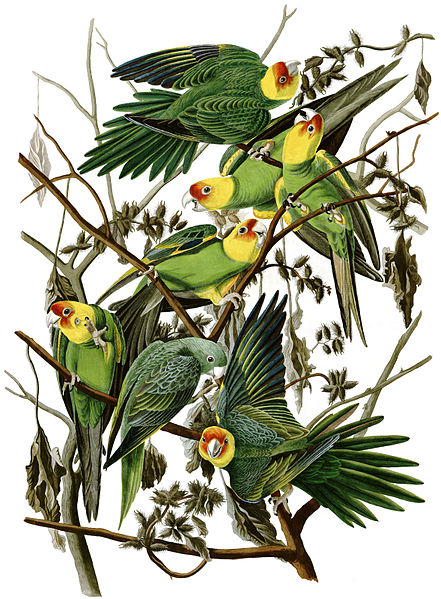
Category Archives: Bird Conservation
Feed SubscriptionParrot Oddities – Three Unusual Species from Australia and New Guinea
 Australia and many nearby South Pacific islands are well known for mammalian oddities such as the Platypus, Tree Kangaroo and Echidna. But Psittacine enthusiasts have much to look for here as well, as the region is also home to some of the world’s most unusual and little-studied parrots. Today I’ll cover a few of the more striking of these – the Pygmy Parrots, Rock Parrot and Green Rosella.
Australia and many nearby South Pacific islands are well known for mammalian oddities such as the Platypus, Tree Kangaroo and Echidna. But Psittacine enthusiasts have much to look for here as well, as the region is also home to some of the world’s most unusual and little-studied parrots. Today I’ll cover a few of the more striking of these – the Pygmy Parrots, Rock Parrot and Green Rosella.
Pygmy Parrots, Micropsitta spp.
Sufficiently unique to have been classified into their own subfamily, the 6-8 species of Pygmy Parrot are found on New Guinea and several nearby islands. They truly live up to their name…the largest barely tops 4 inches in length while the smallest, the Buff Faced Pygmy Parrot (M. pusio), is a mere 3 inches long and weighs but 0.41 ounces! Read More »
Conservation News – No Recovery Plan for the Endangered Thick Billed Parrot
 I’ve been involved in a number of field research efforts, and so am somewhat familiar with the difficulties inherent in funding and implementing conservation work. However, I must admit that this situation is baffling – a recovery plan has not yet been formulated for the Thick Billed Parrot (Rhynchopsitta pachyrhyncha), despite the fact that the bird has been protected by the Endangered Species Act since the law’s inception in 1973!
I’ve been involved in a number of field research efforts, and so am somewhat familiar with the difficulties inherent in funding and implementing conservation work. However, I must admit that this situation is baffling – a recovery plan has not yet been formulated for the Thick Billed Parrot (Rhynchopsitta pachyrhyncha), despite the fact that the bird has been protected by the Endangered Species Act since the law’s inception in 1973!
Help for the US’s Last Native Parrot?
The Thick Billed Parrot is the only remaining Psittacine native to the US Mainland. The other, the Carolina Parakeet, was hunted to extinction in the early 1900’s. With less than 3,000 individuals surviving in the wild, this green and red parrot may be headed for a similar fate if remedial action is not undertaken soon.
To that end, the conservation organization WildEarth Guardians has filed suit against Secretary of the Interior Ken Salazar, seeking to compel the implementation of a recovery plan. Let’s hope for a “parrot-friendly” outcome!
Wild and Captive Status
 Thick Billed Parrots regularly ranged into central Arizona and New Mexico until the early 1900’s, and sporadically until the mid 1960’s. Today they are virtually unknown within US borders. A reintroduction plan instituted by the state of Arizona was not successful.
Thick Billed Parrots regularly ranged into central Arizona and New Mexico until the early 1900’s, and sporadically until the mid 1960’s. Today they are virtually unknown within US borders. A reintroduction plan instituted by the state of Arizona was not successful.
Although far from common in captivity, the birds do breed well when properly provided for… a group I’ve watched for years is a star attraction at the Queens Zoo in New York City. Private keepers have had some success with this species as well, and even provided several of the individuals released in Arizona.
Further Reading
Please see The USA’s “Other” Parrot for more information on this fascinating bird (it forages in the snow!).
Please visit the WildEarth Guardians Website for more on the group’s work with Parrots, Jaguarundis, Tortoises and other animals.
Thick-billed Parrots image referenced from wikipedia and originally posted by Paul Reynolds and Snowmanradio
The Reason We Have Red Factor Canaries – Meet the Red Hooded Siskin – Part 2
Please see Part I of this article to learn about the role this brilliantly-colored bird played in the development of Red Factor Canaries (Serinus canarius). Also known as the Venezuelan Red Siskin or the Black Hooded Red Siskin (Carduelis cucullata), it is highly endangered in the wild, but fortunately breeds well in captivity.
Natural History

Red Hooded Siskins barely top 4 inches in length, but make up in color what they lack in size. Males, clad in vermillion, red and black, are simply spectacular. They are native only to northeastern Columbia, northern Venezuela and Trinidad, where they favor dry scrubland and semi-wooded savannahs. Read More »
Remembering Jake, a Most Unique and Long-Lived Marabou Stork
 Like most old zookeepers, I have a soft spot for old animals. I’ve been fortunate in having had the chance to care for a number of birds that survived to record longevities – a Pell’s Fishing Owl and Smoky Eagle Owl of 50+ years, a tiny Egyptian Plover that lived into its 20’s, and any number of Parrots. But it is a “50-something”-year-old Marabou Stork (Leptoptilos crumeniferus), known to his Bronx Zoo caretakers as “Jake”, who stands out most vividly in my mind. Read More »
Like most old zookeepers, I have a soft spot for old animals. I’ve been fortunate in having had the chance to care for a number of birds that survived to record longevities – a Pell’s Fishing Owl and Smoky Eagle Owl of 50+ years, a tiny Egyptian Plover that lived into its 20’s, and any number of Parrots. But it is a “50-something”-year-old Marabou Stork (Leptoptilos crumeniferus), known to his Bronx Zoo caretakers as “Jake”, who stands out most vividly in my mind. Read More »
 That Bird Blog – Bird Care and History for Pet Birds
That Bird Blog – Bird Care and History for Pet Birds
